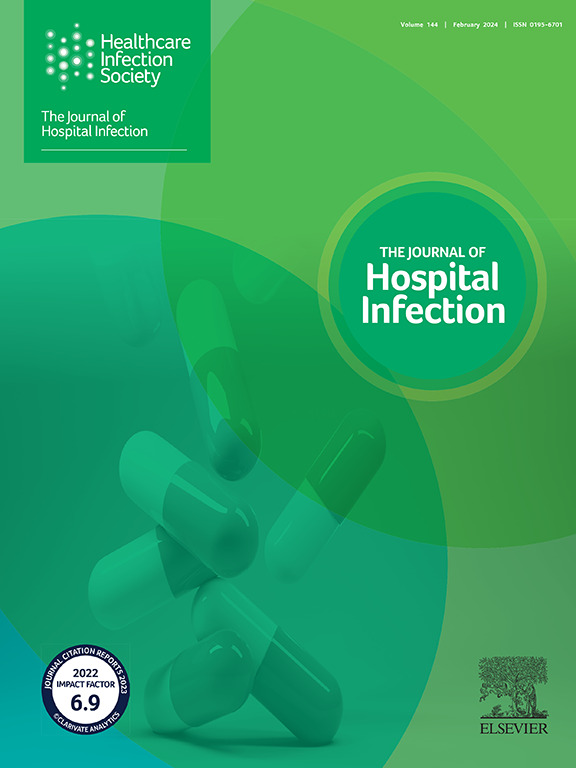护士主导的注射安全可伸缩针的设计与评价。
IF 3.1
3区 医学
Q1 INFECTIOUS DISEASES
引用次数: 0
摘要
目的:针刺伤仍然是临床环境中血源性病原体暴露的重要来源,有助于护士之间的卫生保健相关感染。现有的安全装置依赖于用户的顺从或管理控制,这在现实世界的压力下是不够的。本研究评估了护士设计的可伸缩安全针(RSN)的感染控制潜力,该针通过NIOSH控制层次定义的替代水平工程,从结构上降低暴露风险。方法:采用随机交叉试验对台湾东部某地区教学医院76名护士进行调查。参与者完成了两个模拟临床注射任务,一次使用传统帽型安全针(CSN),一次使用RSN。使用广义估计方程(GEE)比较安全性和可用性结果,考虑受试者内效应和顺序效应。结果:与CSN相比,RSN显著减少了近射事件(平均差值:-0.62次,P = 0.002)、针暴露频率(平均差值:-7.47次,P < 0.001)和针暴露累计时间(平均差值:-27.68秒,P < 0.001)。虽然RSN显示出更好的安全性结果,但它需要更长的准备时间(平均差异:75.6秒,P < 0.001)。两种设备的可用性得分无显著差异(P = 0.156)。结论:RSN提供了一种实用的感染控制创新,从结构上消除了暴露途径,而不是依赖于下游行为。本研究支持护士主导的设备开发,以推进基于工程的策略,以减少职业暴露和提高注射安全性。研究结果可能为未来药物制备系统的实施提供信息,以减轻医疗保健相关感染。本文章由计算机程序翻译,如有差异,请以英文原文为准。
Nurse-led design and evaluation of a retractable safety needle for injection safety
Objective
Needlestick injuries remain a significant source of bloodborne pathogen exposure in clinical settings, contributing to healthcare-associated infections among nurses. Existing safety devices rely on user compliance or administrative controls, which are insufficient under real-world pressures. This study evaluates the infection control potential of a nurse-designed retractable safety needle (RSN), developed to structurally reduce exposure risk through substitution-level engineering, as defined by the Hierarchy of Controls framework of the US National Institute for Occupational Safety and Health.
Methods
A randomized crossover trial was conducted with 76 nurses at a regional teaching hospital in eastern Taiwan. Participants completed two simulated clinical injection tasks, once with a conventional cap-type safety needle (CSN) and once with an RSN. Safety and usability outcomes were compared using generalized estimating equations, accounting for within-subject and sequencing effects.
Results
Compared with the CSN, the RSN significantly reduced near-miss events (mean difference: −0.62 occurrences, P = 0.002), frequency of needle exposure (mean difference: −7.47 occurrences, P < 0.001), and cumulative duration of needle exposure (mean difference: −27.68 s, P < 0.001). While the RSN demonstrated improved safety outcomes, it required significantly longer preparation time (mean difference: 75.6 s, P < 0.001). Usability scores did not differ significantly between the devices (P = 0.156).
Conclusions
The RSN offers a practical infection control innovation by structurally eliminating exposure pathways rather than relying on downstream behaviour. This study supports nurse-led device development in advancing engineering-based strategies to reduce occupational exposure and improve injection safety. Findings may inform future implementation of medication preparation systems to mitigate healthcare-associated infections in practice.
求助全文
通过发布文献求助,成功后即可免费获取论文全文。
去求助
来源期刊

Journal of Hospital Infection
医学-传染病学
CiteScore
12.70
自引率
5.80%
发文量
271
审稿时长
19 days
期刊介绍:
The Journal of Hospital Infection is the editorially independent scientific publication of the Healthcare Infection Society. The aim of the Journal is to publish high quality research and information relating to infection prevention and control that is relevant to an international audience.
The Journal welcomes submissions that relate to all aspects of infection prevention and control in healthcare settings. This includes submissions that:
provide new insight into the epidemiology, surveillance, or prevention and control of healthcare-associated infections and antimicrobial resistance in healthcare settings;
provide new insight into cleaning, disinfection and decontamination;
provide new insight into the design of healthcare premises;
describe novel aspects of outbreaks of infection;
throw light on techniques for effective antimicrobial stewardship;
describe novel techniques (laboratory-based or point of care) for the detection of infection or antimicrobial resistance in the healthcare setting, particularly if these can be used to facilitate infection prevention and control;
improve understanding of the motivations of safe healthcare behaviour, or describe techniques for achieving behavioural and cultural change;
improve understanding of the use of IT systems in infection surveillance and prevention and control.
 求助内容:
求助内容: 应助结果提醒方式:
应助结果提醒方式:


